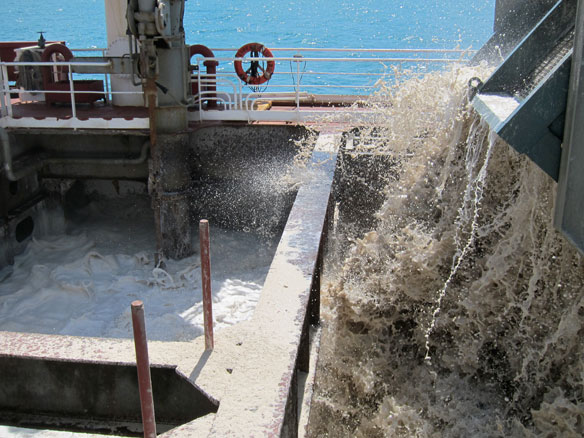
Onboard a sand dredger.
“Sand is the second most consumed natural resource, after water. The construction-building industry is by far the largest consumer of this finite resource. As of 2011-2012, when investigative filmmaker Denis Delestrac and team, were collecting and unveiling sand mining datas and information from the professionals involved, “…the sand business was estimated to be a $70 billion industry, worldwide…!” Captions and Photograph by Award-winning Filmmaker: ©2013 Denis Delestrac
Excerpts;
Ocean City vacationers may notice deeper, wider beaches, the result of a $282 million sand-dredging project aimed at protecting the resort town from storm damage. But the work also raises concerns about surf injuries and swimmer safety.
Over the winter, the Army Corps of Engineers pumped enough sand to fill 275 Olympic-size swimming pools onto Maryland beaches, a chore jointly funded by the state and federal governments…
Read Full Article; The Washington Post (06-01-2018)
Widening beaches might bring more hazards, researchers say; Sun Sentinel (04-04-2018)
Widening beaches might be linked to an increase in accidents, according to new data. The number of ocean rescues spikes after beaches are buffed up, according to the data published in the Journal of Ocean Research…
Why This Treacherous Hawaiian Beach, Keeps Breaking People’s Necks, The Washington Post (10-27-2015)
Adding new sand didn’t merely widen the beaches, they found — it made them higher, “resulting in steep slopes that can cause large waves to break close to shore. In other words, replenishment was doing to Delaware’s beaches what nature long ago did to Hawaii’s Sandy Beach…
Piling sand to stop erosion ultimately made the land sink, study says, NOLA (12-26-2015)
Coastal geologist criticizes beach renourishment efforts; By Robert S. Young, PhD; The State (08-17-2016)
Rob Young, who heads the Program for the Study of Developed Shorelines at Western Carolina University, said the government is subsidizing coastal development with renourishment money – and that’s costing taxpayers. Communities across the country have spent millions of dollars renourishing beaches. Those efforts encourage people to rebuild after every major hurricane…
Palm Beach Mid-Town Dredge Project, A Youtube Video (02-04-2015)
“Beach nourishment projects like this have become commonplace along the US East and Gulf Coasts. These projects have immediate environmental impacts through burial of nearshore habitat and increased turbidity during project placement.The cumulative environmental impacts of doing this repeatedly on the same beach while conducting projects from Maine to Texas is unknown. But, we should be concerned. ” —Robert S. Young, PhD, Director, Program for the Study of Developed Shorelines, Professor, Coastal Geology, Western Carolina University
Beach replenishment may have far reaching impacts on ecosystems;” Phys.Org (03-29-2016)
UC San Diego biologists who examined the biological impact of replenishing eroded beaches with offshore sand found that such beach replenishment efforts could have long-term negative impacts on coastal ecosystems…
Coastal erosion needs our attention, South Coast Today (01-04-2016)
Rethinking Living Shorelines, By Orrin H. Pilkey, Rob Young, Norma Longo, and Andy Coburn;Program for the Study of Developed Shorelines / Western Carolina University, March 1, 2012, Nicholas School of the Environment, Duke University
In response to the detrimental environmental impacts caused by traditional erosion control structures, environmental groups, state and federal resource management agencies, now advocate an approach known as “Living Shorelines”that embraces the use of natural habitat elements such as indigenous vegetation, to stabilize and protect eroding shorelines.








